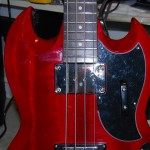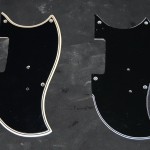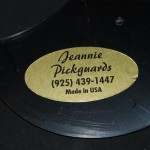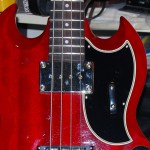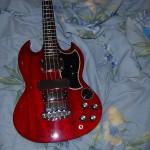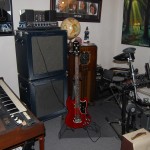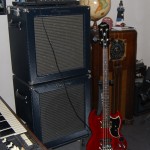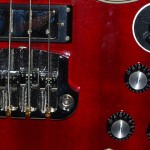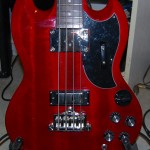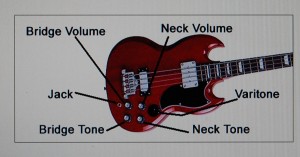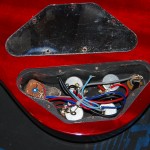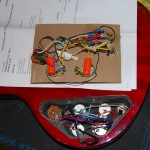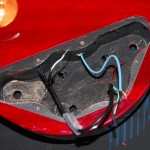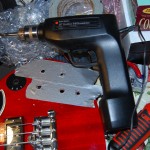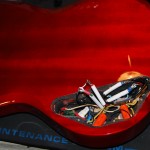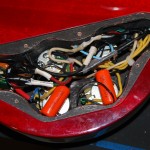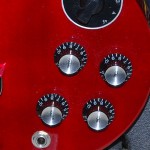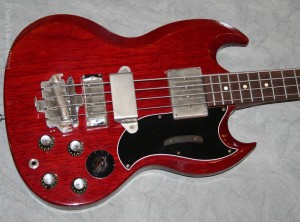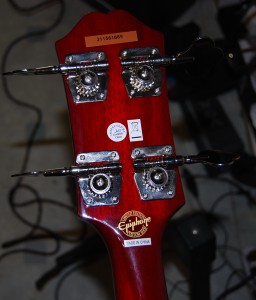Archive for November, 2013
3 easy mods to make your Epiphone EB3 Bass Great! Part 3: Jeannie Pickguards!
If you missed
Part 1: 3 easy mods to make your Epiphone EB3 Bass GREAT!!!!! Part 1: Epiphone Bass Parts. Varitone
Part 2: 3 easy mods to make your Epiphone EB Bass GREAT!!!!! Part 2: Epiphone Bass Parts. Bridge work,
and would like to read the posts in sequence, or would like to review, this is a good time to dig into the whole story!
The last modification to the Epiphone Custom Shop EB3 is more in the area of aesthetics as opposed to pure function but remember what I said about how a clean guitar sounds better and a car runs better? Well then, don’t question it, will ya?! Just take my word for it unless of course, you already know this tautology! It is just the way it is. Looking at the bass I really was not happy with the pick guard. I mean Epiphone pickguards are mostly okay and sometimes awesome as delivered stock but in this case it was somewhat lackluster to say the least. Similar to your small sized Gibson SG pickguard but a bit less exciting. this stock Epiphone bass guitar pickguard was 4 layer black/white/black/white and had a thin edge bevel. Part of the guard was not beveled at all. What’s up with THAT!, Dr. Epiphone??!! You guys have no bevel machine?! Such a nice looking bass and such a lack luster pickguard? I mean after all this revamping of the bass, it really needs a vintage style pickguard to play its best, yeah?
So once again an Internet search is in order. I come across a site named Jeannie Pickguards. http://home.comcast.net/~pickguards/ Pretty cool site. They do some nice custom work. I also noticed afterwards that they had a running listing on Ebay for a vintage style Gibson/Epiphone EB3 pickguards amongst other offerings. The pickguard in the listing had 5 layers black/white/black/white/black and the layers were a bit thicker; sweet! The thicker pickguard lends itself to a nice wide vintage style bevel which has that old Gibson EB3 vibe to it. Just what I was looking for! I went for it. There is a process involved for getting it built though and at this point I became well acquainted with Roger who is the irascible gent that actually custom builds the pickguards at Jeannie Pickguards. I was instructed to take off the original stock pickguard and send it to Roger so he can use it as a template. This was a must because without it there was no guarantee the pickguard would fit. He also wanted to know the year of the bass. I told him that it was an Epiphone Custom Shop EB3 Bass made for the Japanese market only and was produced in 2011. Okay, fine. I sent Roger the pickguard and the funds for the new one ( forty five dollars ) through Paypal and waited for both pickguards to arrive back.
In the meantime Roger calls me and leaves a message to call him back and so I did. He wanted to know if I would like cream instead of white sandwiched in with the black. Very nice of Roger to consider calling me on that one being that the white vs. cream concept was not even in my life space up to that point, just figured it was going to be a new pickguard and white is the arbitrary color choice to counter balance black, period. Roger is starting to grow on me now. Maybe I was a bit premature labeling him irascible and actually telling him he should be nicer? I remember when we had that discussion on the phone he said to me; “I really AM a nice guy!! Problem is you can easily misjudge a person and his tone/intentions by what he states on the internet”. Really can’t dispute that. Can’t tell you how many times I pissed people off and started arguments because I was either misunderstood or taken way too seriously when I was only playfully busting balls in my emails!
Anyway, without hesitation I went with Roger’s suggestion as the cream color off sets the black very nicely and gives the pickguard the appearance of years of fading and yellowing which is perfect for the vintage look. A week passes but it feels like a month because I am like a kid on Christmas day simply busting for a look before it is time to open the presents. The pickguards finally arrive! I archive the stock pickguard with the stock bridge and the stock wiring harness. The pickguard looks perfect, installs perfectly, and completes the look. Simply love it.
Should I stop here or put on the chrome bar cover that the original Gibson EB3 had?
I really have mixed feelings about it. Sure that is the way it was, but I am not sure that an unnecessary piece of chrome bling adds anything to the overall appearance or in fact takes something away. So at this point of indecision, I am not installing it. I really want to make sure I want it there because once the required two mounting holes are drilled there is no way to un-drill them. This is fine for now.
Okay then. All in all, I did throw a few dollars into this bass, actually a bit more than my original investment which some might call me nuts, nuts, nuts!!!, for doing so. First up was the hard shell case www.americanmusical.com/, then the Rothstein varitone circuit http://www.guitar-mod.com/ followed by the Hipshot Supertune bass bridge http://store.hipshotproducts.com/cart.php?m=product_detail&p=264 and finally the Jeannie pickguard. Throw in an extra twenty dollars for the chrome bridge cover in case I decide to mount it. By the way, speaking of the chrome bridge cover, this one is an aftermarket replica. The original vintage chrome bridge covers as scavenged off the old Gibson EB3 basses by the vultures who dismantle perfectly good instruments to sell them part by part are fetching insane money and are tarnished and pitted. As you know I like my instruments new, pristine, and clean as a whistle. Why? Of course because they play better that way! This Epiphone Custom Shop EB3 bass is now everything I want in an EB3 bass without the stellar price tag of a vintage original Gibson. I had a lot of fun with this project and ended up with a great bass. A player for sure, but smokin’ HOT! Hope you enjoyed the adventure as much as I did and thanks for visiting drchucksgearrants!
In my continued search through a plethora of guitar parts on the market I will need to address the next issue on this new Epiphone Custom Shop EB3 bass, (or as I search for bass bridge parts I might refer to this as the Epiphone SG bass) and that is intonation. So now we are getting in to the set up phase of making this bass rock! First, I lowered the bridge to the point where they cleared the upper frets without choking and fretting out and also still rang clearly. Now in the lower fret area I saw that there was more “relief” or upper curvature that I like and felt there was room there to get the strings a bit closer to the fingerboard. Off comes the truss rod cover, insert the truss rod wrench and very slightly turn clockwise checking between increments. As the truss rod is adjusted in this fashion, the relief is lessened, the neck becomes flatter and the strings get closer to the fingerboard resulting in lower more comfortable action. What I want is to get the playing action as close and effortless as possible while also allowing the strings to ring out clearly. When the strings are high they ring out clearly. When they are too low they become stifled and somewhat dead in sound, and also quite often buzz. My goal is to reach that particular “sweet spot” in between these polar opposites that gives me the best of both worlds; comfortable playing action and great tone.
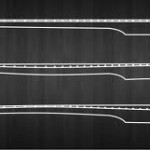
Trying to get to get the bass strings as close as possible while still allowing them to ring out requires minimizing relief but avoiding back bow on the Epiphoine EB3 or Epiphone SG bass.
After a few tweaks of the truss rod of about an eighth of an inch each time, I get there. Doing a test run, it plays really good, but after tightening the truss rod, I have a little buzzing on frets 19 and 21. Feeling that they may need to be filed and dressed, I resist the urge and let the bass sit for two days after the neck adjustments. This is a good idea because we are dealing with wood. By tightening the truss rod, I increased the tension and stress on the neck. Quite often after getting things really nice, you can come back a day or two after to find out that the neck responded more than you might have anticipated leaving you with less than ideal relief, in which case you have to go back in and readjust in the other direction to lessen the tension and bring the neck back to where you wanted it.
Sometimes you have to repeat the process, sometimes not. Like I said it is wood and that leaves a percentage of uncertainty with respect to truss rod adjustments.
As it turned out, there was no change at all after a couple of days. Out came the fret files. This can get tricky as you will see. I stated that frets 19 and 21 were buzzing just a bit. First I cleared fret 19 by slightly taking down fret 20. Good so far, well not exactly because fret 20 was now buzzing against 21 where it wasn’t previously. Now I take down fret 21 and all seems pretty good except for just the slightest buzz of fret 21 against fret 22. A slight filing of 22 corrects this. Then I get my fret dressing and polishing kit out to smooth down the areas where I adjusted and leave a mirror like surface once again. Nice action, clear bell like tones. Cool. Apply a thin coat of lemon oil to the fingerboard, work it in, buff it out.
The lesson to be had from this is that when you eliminate a buzz somewhere on the fingerboard, often afterward, you start to chase that buzz all the up the fingerboard. In this case when fret 19 buzzed against fret 20, I ended up filing all the way up to the last fret to get it right. So you have to be careful, VERY careful not to overdo it, especially if you have a problem much lower down the neck. You have to be very patient and make very slight adjustments when filing a fret, constantly checking and rechecking. You can easily take away height but if you’ve gone too far, you have a potential nightmare on your hands. So if you are ever inclined to do this to a guitar, grab yourself a cold Miller 64, sit back for a few minutes and enjoy, then really consider whether you are up to the job. If you have never done any fret work or set up work you might want to consider acquiring a nice cheap guitar on Ebay and hone your skills a bit before you go out and start messing with one of your keepers, or let an experienced tech do the job for you. I have been doing this for a long time and I still have some dicey moments that I start to cut a sweat over. So far, knock on guitar neck, no disasters.
Next intonation check. Everything is within normal limits and sounds good except for the G string. The 12th fret octave is noticeably sharp of the harmonic. What to do? In order to bring the octave down you have to increase the overall string length between the bridge and the nut. I then adjust the bridge saddle so that it is further away from the nut. I do this until the 12th fret octave rings true with the harmonic. Now there is another problem. As it turns out, the more the saddle is adjusted away from the nut, the closer the string becomes to the neck. With the intonation adjusted properly, the G string is too close to the neck and fretting out. It should be a simple fix, right? Simply raise that saddle until the string height falls inline again with the other strings. Problem is, Epiphone and well as the Gibson EB3 have only a two way adjustable bridge. You can adjust the entire bridge in terms of height and the bridge saddles individually in terms of intonation but you cannot adjust the individual saddles for string height. This really sucks, especially when I am now so close to reaching “set up Nirvana”.
What can be done. I can adjust the bridge as a unit to where the offending G string sits properly which would make the other strings unacceptably high, and then file down the remaining saddles until they all line up with this SOB of a G string! Extremely labor intensive to incrementally file a steel bridge saddle until it matches and then do it two more times while making sure that the intonated spot on the saddle adjustment screw is not altered. I think I’d rather experience Chinese water torture than go through that. So throwing my hands up in the air I came up with a quick effective but very cheesy fix. I took out a fat rubber band from my junk drawer that was used previously to hold a lobsters claw closed. I am sure you know the type. Small diameter, wide, and thick. I cut two vertical slices from the rubber band and place one under the G string saddle to raise it. Not bad, but not enough. Add the second slice and that does it. I have raised the saddle with two chunks of rubber. Not very elegant and I am not really happy about this but is effective for the time being and does the job.
In the meantime I sort through as many guitar blogs and guitar parts blogs and websites for Epiphone Bass Parts as I can find relative to this problem. Honestly, I think this is a design flaw and both the Gibson and Epiphone bridge are pretty much the same. In fact, the original Gibson EB3 bass didn’t even have intonatable bridge saddles but simply a raised berm on the bridge to approximate where everything might be correct. 2 way adjustable is bad enough. That must have stunk even worse considering the the only adjustment possible was to raise or lower the bridge height only as a unit!
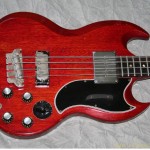
Gibson EB3 Original One Way Adjustable Bridge Not very adjustable at all! One size fits all intonation!
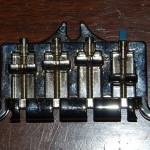
Epiphone stock 2 way adjustable bass bridge. Note lobster claw rubber band segments for G string height adjustment. Yipes!
Oh well, that’s life I suppose… Then I happen to come across what might very well be the solution!!! Noodling around Ebay I see something that is the answer and the second easy mod that will make this bass ROCK! It is called the HIPSHOT Supertune Bass Bridge. For further information click on this link:http://store.hipshotproducts.com/cart.php?m=product_detail&p=264
This is a direct no modification replacement 3 way adjustable bridge for Gibson and Epiphone EB3 basses. Looks like EXACTLY what I want!. Ch-ching! Add another $89.00 to the cost of admission but if this mod, like the Rothstein varitone circuit can make a significant improvement on an overall excellent platform it will be worth the investment and so I do a BIN ( Buy It Now ).
The following week the bridge arrives and the install goes smooth as silk taking me seriously about five minutes for the basic install. I tune up to pitch and do a quick adjustment of individual string heights!! Yay!! INDIVIDUAL adjustment!!! The bridge saddles are similar to what you would find on a typical Fender Sratocaster or Telecaster having twp set screws for height adjustment; one at either end of the saddle. Then I adjust all the 12th fret octaves to ring true to their respective harmonics and do a final height adjustment
on all the strings. Wonderful, this bridge totally works, is a beautiful addition, and is built like a tank. Final tune up, plug into my Ampeg B-15R and this bass plays and sounds spectacular. This new chunk of steel bridge really seems to improve the depth and sustain as well and it does make sense. Instead of the old bridge suspended over the top of the bass by three bolts, this bridge is clamped flat against the top by two bolts. The entire bridge assembly rests right on the bass. This Epiphone EB3 bass plays so well now, I really cannot see how one with a Gibson name on the headstock could outdo it!!
Next up; 3 easy mods to make your Epiphone EB3 Bass GREAT! The Finishing touch!
Part One: Tone Launch though “varitone”…
Okay, here we go. Next up on 3 easy mods, we’re plugging the new Epiphone EB3 Bass in to my Ampeg B15R (awesome vintage inspired bass amp!) Volume up, tone up. What no varitone? NO VARITONE circuit?!! What?!! ARE YOU %*&$*%#!!! KIDDING ME?!!! And so I discovered that what looked like a varitone was not one at all. Such dastardly wretched duplicity!!! Such deceitfulness!!! A simple chicken head knob with three positions: neck pick up, neck and bridge pickup, bridge pickup. Basically this is the same circuit as on your garden variety toggle switched Les Paul, dressed up to look like a varitone!!!
What a bummer, what a misconception! I felt like I was misled at first, but in reality this basic three piece circuit was staring me in the face. On close inspection of the control plate underneath said chicken head knob were the numbers 1,2,3. That’s it. Right out there in the open, NOT hiding! I just never expected to see them and so I didn’t,.. obviously. All I saw was the preconceived 4 position varitone circuit in my mind and displaced it on to this bass until suddenly the dawn of reality rushed in. Don’t get me wrong, the bass sounded pretty darn good as it was, but to me, it wasn’t an EB3 without a varitone circuit , dig?
So what to do? And so I searched the net for any Gibson EB3 varitone circuit equipped wiring harnesses figuring that there must be some floating around as presented by the host of scavengers who in their vulture like fashion dismantle perfectly good instruments to part them out and sell the guitar parts for a tidy piece by piece profit. Nothing… Ebay had nothing. Nobody had anything except once in a while a choke which is a part of the circuit, would show up. A lot of good a choke is going to do for me, a person who is not about to construct a wiring harness from scratch even though there are schematic diagrams for this control set up available on the net for this purpose.
I kept putting in searches for the circuit varying the theme here and there to see if I could get a different result somehow. Then I came across a very interesting site called Rothstein Guitars: http://www.guitar-mod.com/# They claim that the “cornerstone of their business is their highly regarded prewired assemblies”. I searched through the site but could find nothing that would meet my needs and so I decided to shoot off an email to Andy at Rothstein Guitars to see if they could help me out.
Hi Andy,
I recently bought an Epiphone Custom Shop EB3 bass. I did not realize until I got it that what looks like a varitone is not. The rotary switch is 3 position only and is really simply a rotary pick up selector. Not that this is inherently a bad thing and it does work as expected, but I was hoping that this bass had the four position varitone circuit which it does not. I guess this was done simply to mimic the look while keeping costs down.
Anyway, I came across your site and was hoping for an “Ahaaaa!!” moment but did not find what I was looking for. By any chance would you make a pre wired Gibson EB3 varitone circuit assembly that I could install in this bass or know where I might find such an assembly?
Thank you very much.
Very Sincerely,
Chuck
With my last ditch effort to upgrade this bass to the way it is supposed to be I patiently waited for a response………….. A few days later I checked my email inbox and there it is! An email from Andy at Rothstein guitars!!!
Chuck –
We have had quite a few people ask us for wiring harnesses for EB-3 so we have been planning on offering some mods. We manufacture our own varitone (Platinum Lab Varitone) that is 6 positions (5 filters and a true bypass). http://www.guitar-mod.com/Merchant2/merchant.mvc?Screen=PROD&Product_Code=V6B&Category_Code=MID We could certainly wire up a harness that has 2 independent volume and tone pots, as well as a master varitone. There would of course be no method of pickup selection, except by lowering the volume of which ever pickup you want to shut off.
Regards,
Andy
I got back to Andy to let him know that I liked what he had to say and wanted to proceed with designing this.
Hi Andy,
That sounds great! And as far as your statement; (There would of course be no method of pickup selection, except by lowering the volume of which ever pickup you want to shut off ) that wouldn’t be a problem as my ’62 reissue Fender jazz bass has the same situation and it never bothered me. I do like the fact that it would be wired and ready and that it is inherently superior with 5 selections and true bypass. If you could get back to me with regards to pricing and shipping I would greatly appreciated it.
Thanks,
Chuck
Bingo!!! And so Andy and I went back and forth a bit on the design layout for this circuit until we decided what worked best. In the meantime a seller on Ebay that I inquired to about the same thing finally got back to me telling me that he could faithfully replicate the 4 position varitone circuit as was used on the Gibson EB3 but by this time I was totally stoked with the Rothstein 6 position design which I thought was a far superior approach and so I stuck with it. I know what you are thinking; “He’s deviating from the original design!!” Look, this bass will never really be a replication of the Gibson EB3 anyway as it says Epiphone on the headstock, yes? Not that I have a problem with that as previously discussed in my last post; Gibson EB3 Bass. “CREAM” of the crop. Why you need one! Even the Epiphone Elite which is as close to original as you can get will, like this one, only be technically considered a “tribute” instrument. Okay, so who really cares about this semantic game? As it is so poignantly said at times like this; “it is what it is”; let us move on……
I sent Andy the pre requisite $150.00 plus shipping and then anxiously waited for delivery of my new 6 position varitone circuit equipped wiring harness.
Okay! A few weeks later it finally arrives!! I open the package and there it is totally laid out and labeled on a piece of cardboard ready for drop in installation. I guess this is the equivalent of a heart transplant for an electric bass and it is time to get the patient prepped for surgery.
First thing is to lie it on my rubber guitar mat face up. I remove the knobs and the all mounting hardware from the existing wiring harness. Next flip the bass, open and remove the control panel cover, de solder the pickup connections, ground wire, and make a note of what goes where for future reference. Okay, next is to lift out the wiring harness leaving a stark bare control cavity awaiting its new heart.
You know how they say that things don’t always go as expected? Well, one thing I didn’t anticipate was that the potentiometerswould be so heavy duty and therefore with a larger girth on the Rothstein harness that they would not fit through the existing holes. Time to get the drill out! Talk about heart transplant! Now this is getting as serious as a heart attack to me!
The wood in this area is so thin that it could easily split and shatter should the drill bit “grab” the wood. Looking back, I think I could have slowly and methodically filed the holes to a larger size, but at that time in my excitement and rush to get the install done, it never dawned on me to employ this safer approach. What I did do for precaution was to tape off the areas to at least give the wood some reinforcement. Okay, I sized up the drill bit to match the potentiometer took, a deep breath, and drilled out four holes. Exhale!!! …..Went smooth as silk. Whew!! Luckily the varitone switch and output jack fit with no alteration.
Next, I dropped in the new “heart”. Just made it!! If those potentiometers were any wider I would have had to enlarge the control cavity. It was that close. I then reattached the pickups and the ground wire.
I had to sort of press and fit the wiring as the control cavity was now pretty much filled to the max with wiring “business”.
Screw the control cavity cover plate back on, flip the bass over, mount the pots, knobs, and chicken head varitone knob and we’re set for a test run.
Once again plug into my Ampeg B15R and power up. Nice!!!! Clear, deep, middy full, versatile, are some of the adjectives that immediately come to mind. Okay so here is the basic theme to the varitone. Position One is quite trebly and can actually do a good approximation of a Chris Squire Rickenbacker Bass; clean and deep but also with just a bit of EB3 darkness thrown in. From there as you progress through to position 5 the treble slightly attenuates and the midrange becomes accentuated. Position 5 gives you considerable “bark” and it is so satisfying it might make even Jack Bruce smile!! Position 6 is true bypass meaning that as the varitone circuit is disengaged, there is no defaulting coloration to the bypassed tone. In bypass, it is as if the varitone circuit was never installed.
Bear in mind that with this circuit, even tiny adjustments to the volume and tone mix can yield some very unique tonal differences and because you decide what pickups you want on with the volume control you can even varitone a single pickup, or any combination of both pickups together. The tonal possibilities are quite endless!!
All in all, I could not have been happier with how things came out despite it added another $150.00 to the price of admission.
Next up, Part 2; bridge replacement.
Today’s topic. Gibson EB3 Bass. “CREAM of the crop. Why you need one! Hey, I am child of the 60’s and 70’s. Gimme a break, okay?! I have always loved the Gibson EB3 bass. Well, at least from the first time I was blown away by Cream. Jack Bruce played bass unlike anybody I had seen before. Not just a blur of nondescript deepness to give some bottom end to a band’s sound, Mr. Bruce was quite articulate, lyrical, and definitely expressed himself with clarity and authority. Sometimes it seemed like he was a frustrated lead guitarist but in a great way, who was competing with and battling with Eric Clapton for the helmsmen position of the band. Jack Bruce would weave his bass lines into his own underlying story behind a song and would counterpoint Eric Clapton’s power chording and soloing at the same time. This put a very satisfying tension into the final product which became their trademark band sound and literally established over night, the 3 piece power trio as a viable recipe for a successful rock band, defined the significance of a singing bass player; no easy feat, and further show cased Cream as a very new and unique force to be reckoned with the likes of which we never heard before and arguably since. This band really put the 3 piece format on the map, the limited success of Blue Cheer not withstanding. I had previously thought that a three piece band no matter what, would sound lacking. What are you kidding me? Cream totally rocked and tore down every venue where they performed. Most honorable mention also to The Jimi Hendrix Experience, Led Zeppelin, 3 piece with a lead singer, and Grand Funk Railroad, Rush, Police; also with singing bass player, Sting, and the list goes on. Nevertheless, Cream, for me, was the band that opened up the existence and gave major significance of the 3 piece band concept to me, and with an explosion of sound! Cream seemed to me to be a very appropriate name as they were arguably the top of the heap and henceforth the “CREAM” of the crop of the three piece genre.
BTW, ever try singing lead and playing bass at the same time? Try it and you will see what I mean when I say; “no easy feat”. Yet, since I first witnessed Sir Paul effortlessly doing just this thing, I was captivated by it. Sort of like the split brain piano thing, but different. Of course we can take that to Good Gestalt; give a microphone to Joey Defrancecso and strap a harmonica on his collar as he right and left hands the Hammond B3, plays bass with his left foot, and mans the expression pedal with his right, whew!!,..but that just might veer us off topic, and so maybe we”l hit that up in another rant at some point in the future. Joey could really host a 2 piece power band; B3 and a drummer! Then again if we gave Mr. Clapton a set of bass pedals back in the day, we might not be having to this discussion. Sheesh!!…Aw heck, Cream would NEVER be the same without Jack Bruce on his EB3, right?!!! Gotta love the Gibson EB3 Bass. And so it is time for a rant!
Gibson EB3 Bass. “CREAM” of the crop. Why you need one! Why you need deep thump!
And so as much as I am a fan of Clapton’s “woman tone”, I am equally enthralled by Jack Bruces fat, clear, and ripping bass tone as well. And how did he get this sound? The Gibson EB3 became the instrument of choice for his sonic onslaught. Chcek out; http://www2.gibson.com/News-Lifestyle/Features/en-us/cream-jack-bruce-eb-3-bass-player-0514-2012.aspx The so called “mudbucker’ pick up at the neck supplied the pounding deep thump and the treble pickup at the bridge supplied the clarity and definition that made Bruce’s bass lines cut though the mix with the authority of a lead guitar solo. The EB3 bass had that certain deep, twangy thump to it and I suspect the short scale had a bit to do with it by giving the strings just a touch more elasticity than a long scale bass. Perhaps’s it was due more to Jack Bruce’s style, but in any case, to me this bass was the best and perfect bass for Cream’s unique sound.
Gibson EB3 Bass. “CREAM” of the crop. Why you need one! Controlling your tone:
The controls are at first pretty straight forward. 2Volumes, 2 Tones. Then instead of the standard toggle switch for selecting pickup combinations, there was a 4 position varitone that would roll off some tones and concentrate others. You could be deep and thunderous, also hard hitting with treble clarity, or dial in tons of mid range bark to your soild foundation which what I loved about Jack Bruce’s Cream sound. this was a passive system meaning no battery powering it, but obviously very effective. For further EB3 history check; http://en.wikipedia.org/wiki/Gibson_EB-3
So here I am years later Jonesing for an EB3 bass only to get sticker shock when I start to scan Ebay and the ads in Vintage Guitar etc. Sure there are bargains available, but they are either beat up or circa 70’s editions which I am not at all fond us as they deviate from the original format of what this bass is all about, at least to me. Abbreviated body contours, the neck pick up moved more towards the bridge, and that dreadful slotted headstock. What’s up with that?! This is neither a classical guitar nor an upright bass feh cryin’ out loud! This a rock bass! Also they had a working formula, why screw with it? Okay so then there is the newer SG bass. Icks-nay! No varitone. Look I’m sure it is a wonderful instrument. The varitone is a line in the sand for me. And the obvious choice now would be an Epiphone Elite. What’s that? The name on the headstock is different, you say? Okay then back to square one emptying your bank account to get one, especially if it is one of the earliest models with the spread out volume and tone knobs like Mr. Bruce used, or just get over it! Problem with the Elite models was they seldom come along and I really did not want to wait. I could consider the standard Epiphone EB3 but it is long scale and has trapezoidal inlays. No way. I always loved even the compact look of the short scale EB3. That was the way it is supposed to be. And so I figured I’d just have to wait and see what come along. After all I am not a gigging bassist at the moment so I really can’t justify any urgency. I just want it damn it!
Refurb
And so a few weeks go by and I spot something on Ebay that really grabs my eye. It is an EB3 bass, short scale, with dot inlays, what looks like varitone with the chicken head knob etc. More about that later. So far so good! The headstock says Epiphone, but the only short scale EB3 I’ve ever seen was the aforementioned Epiphone Elite offering. Hmmm. And so I start to read the description. Apparently this was one of those refurbs where they get the guitar from the manufacturer, “refurbish” it, lose the original serial number, replace it with a new one, and sell it as a refurb, no manufacturers warranty/you’e on your own pal! Sometimes they even stamp a “2” on it as well; sort of like “Scarlet Letter” of musical instruments which designates that it has at least one flaw. Yet,the more I looked at this bass in the photos, the more I liked it. I mean, it even had my beloved deep scarfed contours around those devilish bass and treble horns. Damned that if they didn’t nail the body shape of the original, it was darn close indeed. The price was also right at $299.00. Look when you buy one of these refurb instruments obviously you are not looking for a blue chip investment okay? You are looking for the best representation of what you want with nice sound and playability without laying out breaking the bank. Apparently this rendition of the EB3 bass was intended for sale in Japan only and that is why you might never see one of these without the refurbished pedigree,…. or lack thereof.
Pristine vs. Relic
Another thing I liked was that it was brand new and beautiful. I like my instruments new and pristine. I am not at all a fan of beat up instruments whether it is genuine old mojo or new so called “distressed”or “relic” ized. New and shiny my friends, and I really endeavor to keep them that way. All things considered, if I am going to own a beat up guitar with considerable wear, in my world it will be because EYE am the one who caused it, yeah?! And to pay extra to have someone beat it up for me in order to simulate years of wear and tear? Preposterous! Hey you may like guitars with the paint purposely worn off or the hardware purposely tarnished and rusted, or to have your guitar worn and beat to look exactly like your favorite performer with wear marks, scratches, and dings perfectly replicated. Fine, I can accept that . To each his or hers own, I suppose. Just not for me. New and shiny. Did I say new and shiny? Also clean. Yes, to me a clean instrument like a clean car just performs better. Don’t ask me why, just take my word for it. Go polish your guitar and wash your car. Shiny and clean is very good! Your instrument will sound better, and your car will run smoother. Yes.
And so I took the plunge and hit the buy it now. Of course add another $89.95 for an Epiphone hard shell case. If you want to keep your axe in mint shape, a hard shell case is a must. Still all in all a relative bargain.
About a week later the bass arrives ahead of the case. No biggie. I’ll carfully store it in the shipping box until the case arrives. And so with great anticipation I unwrap the bass and give it the raised eye brow scrutinizing inspection. Simply beautiful. I can’t find a flaw anywhere. Deep cherry with nice grain just like its uptown Gibson cousin. Clean and shiny. The beautifully scarfed contours look even better in person. Okay so the headstock doesn’t say Gibson and it is a bit elongated in comparison to the Gibson headstock. T o me being a life time fan of Epiphone remembering the glory days when they were made in the same factory as Gibson, I never had any bias towards the brand and loved the name and logo etc. Yep, not a Gibson in name, but a beautifully inlaid and executed headstock over all. Nice period perfect elephant ear tuners add to the vintage Gibson,… er, Epiphone vibe.
I tune her up and off the bat the action is simply awful. No surprise. I’ve never purchased a guitar that I liked the action on the mark right off the bat and some, like Martin acoustics, can arrive downright finger slicingly high to the touch and in my book, totally unacceptable. Yep, this baby was definite;y going to need a set up, just not tonight. Tonight is just for checking out the bass, evaluating it and deciding what has to be done to make it totally kick ass. In any case, the build quality overall looks excellent, the fret board looks like a nice slab of rosewood and the finish is beautiful, No orange peel or paint drips to be found. Just beautiful. The scale length is right on target, the balance of the bass is really nice and the weight seems just right. Knock on the body and it has a nice ring to it. Acoustically the bass sounds bright and clear.
First impressions in summary:
Got the bass. It has it’s pluses and minuses and the pluses GREATLY out weight the minuses, which is a good thing.
On the plus side:
1) Scarfing or Body Contours are deep, correct and satisfying.
2) Build quality for the ridiculous low price is outstanding.
3) Required minimal set up to get very low action with no buzzing.
4) Cherry Color is deep, rich, and Gibson correct.
5) Pickups are loud, deep, and clear.
6) Tuners are vintage correct tributes and hold tune perfectly.
7) Intonation acceptable if not perfect out of the box.
8) Bridge somewhat adjustable.
9) Fit and finish is outstanding. No lacquer drips, orange peel, overspray or underspray. Excellent gloss.
10) Fret dressing is excellent. No sharp edges when you run your hand up and down the neck which is
typical in this price range.
11) Epiphone mother of pearl logo headstock inlay as well as the Gibson crown inlay excellently done.
12) Set neck heel joint which is ridiculous in itself at this entry level price is as precise and as aesthetic as on
my $4000.00 Gibson Les Paul/SG Custom.
13) Rear Body cavity electronics access cavities are excellently cut. The body covers fit perfectly with
Very uniform “gappage” surrounding.
14) Overall, looks, feels, and almost sounds * like it’s up town and more expensive Gibson cousins.
On the minus side:
1) No case included. At this price, no surprise.
2) The pick guard does not have the vintage WIDE bevel that I love. Well neither does the
current Gibson SG Bass.
3) No chrome hand rest cover later relocated to a bridge pick up cover. Again, the current
Gibson SG Bass lacks this as well.
4) * Most importantly and MOST disappointing at least to me, NO VARITONE. The bean counters
at Gibson did a good job at baiting and switching on this one. What looks like a varitone set up is simply
a standard 2 pickup arrangement disguised as a varitone circuit. Instead of having a 3 position toggle
switch as on the normal typical 2 pickup Gibson, they used a three position rotary switch instead
to accomplish the same thing while looking VERY “varitonish”. Pretty slick those Gibson bean counting so and sos!!
I did not notice this until I got the bass. Then I went back and checked again. All Gibson EB3 basses have
Varitone, as also does the Japanese Custom Shop Epiphone Elite/Elitest EB3; evidenced by the
FOUR!! Position rotary switch. As it turns out, with the exception of the Elite/Elitest line all Epiphone EB3
basses short or long scale have this duplicitous but subtle 3 position rotary switch arrangement.
What to do?
1) I bought the appropriate Epiphone hard shell case. A no brainer but was a bit difficult to find.
2) I am having a custom made wide bevel pick guard fabricated.
3) Found a cover.
4) After much research and interchange with Rothstein Guitars I am having them build me a
custom made replacement wiring harness with a better than original varitone circuit. Why better?
The original has 4 positions. This one will have 6 and with superior EQ presets than the original;
i.e. 5 tone variations with position 6 being true bypass.
That should get this bass exactly where I want it and STILL be a great deal.
Next up, time to plug in and ‘er it rip.
Please stand by………
To see Jack Bruce “rip it up!” with his Gibson EB3 bass, click on the following link of Cream playing Whit Room:
For some interesting further reading on Gibson basses:
http://www2.gibson.com/News-Lifestyle/Features/en-us/gibson-basses-0705-2011.aspx
